 Regia Marina – 6 destroyers:
Regia Marina – 6 destroyers:Generale Antonio Cantore, A. Cascino, A. Chinotto, C. Montaranari, M. Prestinari, A. papa.
Built 1919-1922, interwar, ww2 (1922-45)
WW2 Italian Destroyers
Poerio | Aquila | Mirabello | Leone | Sella | Sauro | Turbine | Navigatori | Freccia | Folgore | Maestrale | Oriani | Soldati | Medaglie d’OroWW2 Italian Torpedo Boats
Indomito | Audace | Audace(ii) | Pilo | Sirtori | La Masa | Generali | Palestro | Curtatone | Albatros | Spica | Pegaso | Ciclone | Ariete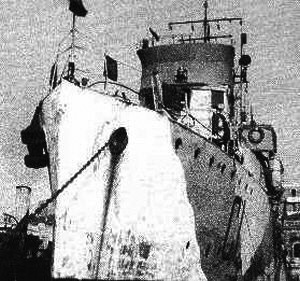 The Generali-class were the last “tre pipe”, or “three stackers” style Italian destroyers, built as a development of the wartime Rosolino Pilo-class and a lineage sthat started well prewar. These were the last Regia Marina “classic destroyers” of a similar tonnage and armament, ordered in 1918, but wartime shortages and priorities considerably delayed their completion to well after the war. They were launched in 1921-22 and completed in 1922. In 1929 they were considered obsolete and reclassified as torpedo boats, fighting in that role in the Second World War. Unlike previous class which saw a few surviving, none of the “generali” survived ww2. Three were sunk by mines, one was scuttled to prevent capture by the Germans and two were captured and scuttled or sunk in 1944-45.
The Generali-class were the last “tre pipe”, or “three stackers” style Italian destroyers, built as a development of the wartime Rosolino Pilo-class and a lineage sthat started well prewar. These were the last Regia Marina “classic destroyers” of a similar tonnage and armament, ordered in 1918, but wartime shortages and priorities considerably delayed their completion to well after the war. They were launched in 1921-22 and completed in 1922. In 1929 they were considered obsolete and reclassified as torpedo boats, fighting in that role in the Second World War. Unlike previous class which saw a few surviving, none of the “generali” survived ww2. Three were sunk by mines, one was scuttled to prevent capture by the Germans and two were captured and scuttled or sunk in 1944-45.
The next Curtatone and Palestro classes, resurrecting old ironclad names, were completely different animals, much larger, armed a different way, and a prelude to later interwar and ultimately WW2 Italian destroyers. A fitting conclusion for December.
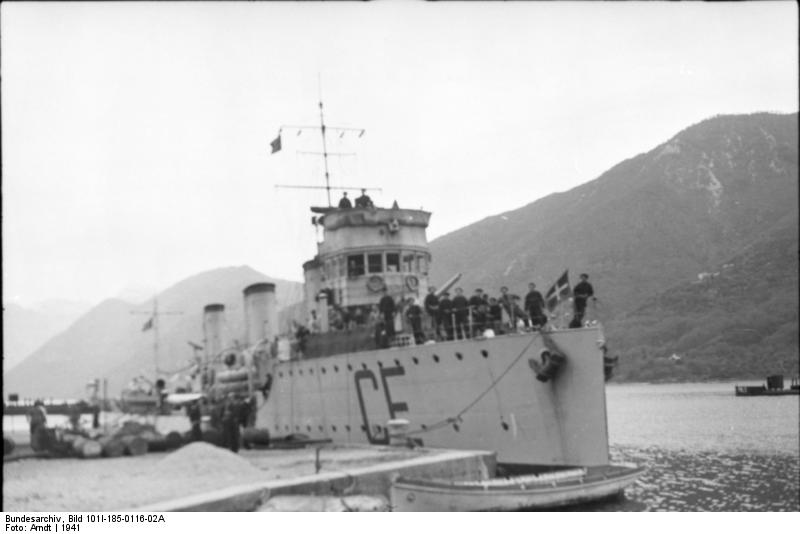
Generale Antonio Cantore
Development
The “Generali” were named as such due to their naming after WWI generals. depending of the publications and authors they are also officially named the Generale Antonio Cantore class, and in some Generale Achille Papa class. This class, designed by Odero Yards of Sestri Ponente, was also known as the third series of the improved Indomitos, and repeated the Sirtori/Pilo class with some alterations: only three 4in (102 mm) guns, 45 caliber long and differently placed 3in or 76mm/40 AA guns instead of the 2-40mm/39 MGs.
They were ordered in 1918 but only laid down in 1919, the first being Cantore, on 11 November 1919, so a full year after the end of WW1…
Completed between 1921 and 1922 by Odero shipyards in Sestri Ponente, these units were an improvement on the previous Rosolino Pilo class, from which they differed with better stability and greater speed.
After 1929 they were reclassed as torpedo boats, and by 1936 equipped to be able to carry out minesweeping. Their armament was modified later in WW2 (see below).
During the Second World War they served indeed as convoy escorts, especially to and from Greece and Albania and on coastal routes between ports of the Libyan coast.

Generale Carlo Prestinari
To go back on the design, they were obsolete already when ordered in 1918. Indeed, at the time, the British Royal Navy opted for larger vessels, between the new flotilla leaders (scott class for example), which dwarved them at 2500t, were faster and far better armed, including 533 mm or 21 inches torpedoes among others. Even th new standard V-W were much larger, at least by 600 tonnes, and armed almosy the same way. This was a reaction to German late destroyers, some of which even were armed with 15 cm guns. For the next Curtatone/Palestro classes, very close together, a completely new approach, quite unique to Italian destroyers was chosen. These were two funneled ships, still small tonnage (890 tonnes fully loaded, the same as the Generali) with a longer forecastle for added buoyancy, more beam for larger turbines and much more power and speed. The extra buoyancy on the forecastle was due to the adoption of twin mounts for the main guns, which presented several advantages. These will be covered in December.
Design of the class
No plans found yet.
Hull and general design
The “Generali” roughly shared the same hull, with the previous Pilo class. Displacement instead of 770 tonnes standard and 806 tonnes fully loaded was however now heavier at 832 tons normal and 890 tons full load. They were about the same size as the Pilo, just 2 inches or 50 cm longer at 73.5 meters overall (241 ft 2 inches) for the same beam at 7.3 meters (24 ft) but with a 3 meters (9ft 10 in) draught instead of 2.7 m (9 ft 2 in).
The forecastle was still 1/4 of the total lenght in proportion, they had the typical inverted near-straight bow (longer at the waterline and chin) improving seakeeping qualities, broad prow with moderate flare. The long same-beam hull pas the forrecastle had even fuller forms, and ending in a broad rounded prow. The stern rudder protruded and was still attached directly on the poop, using a backup steering system. The bridge forward ws the same as before, with small map room at its based, topped by the enclosed fully glassed bridge, and an open bridge above, with barriers wrapped in canvas.
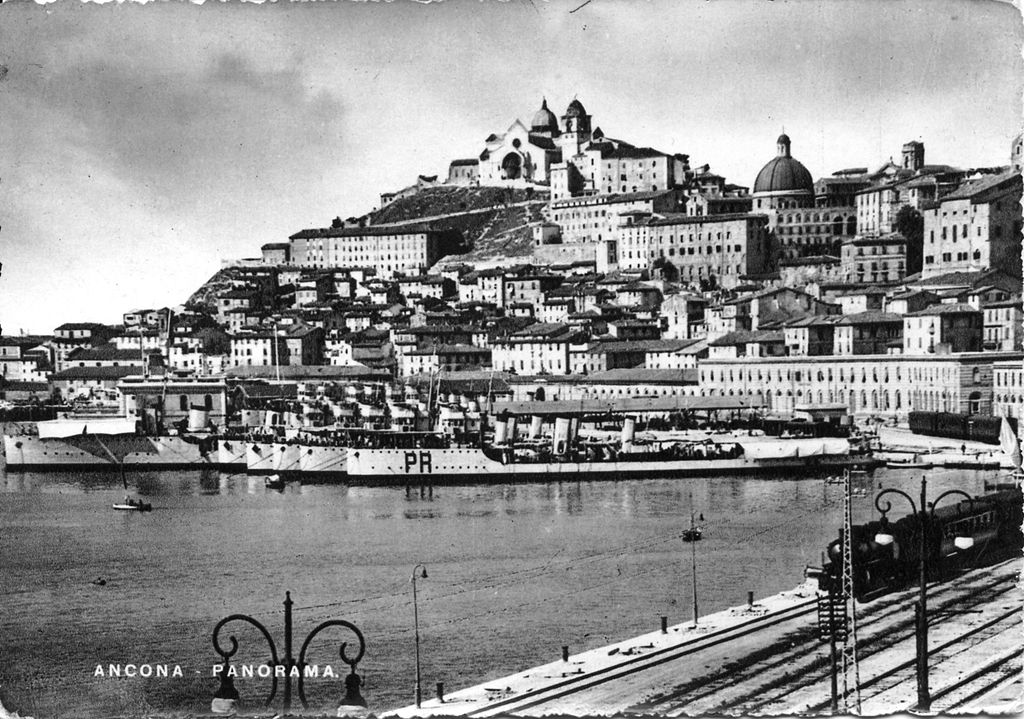
Prestinari in Ancona
There was a single mainmast forward of the bridge supporting a spotting top. The bridge had a platform for a main fire control telemeter. The foremast supported radio cables set on the small aft mast. They were raked like the three funnels. The middle funnel was larger due to its double truncated exhausts. There was a double steering wheel aft behind the aft mast and single light projector on the bridge’s roof plus two small morse projectors on the wings. The Genrali class ships carried a complement of 105, between perhaps 15 officers and 85 ratings and they had two service boats under davits and a serie of life rafts.
Powerplant
The Odero yard could not do wonders wit the powerplant, and only by having a better width/lenght ratio speed could be improved a bit, but internal space was just lacking for a large powerplant. Like the previous classes, they had two shafts, mated on two steal turbines (likely Tosi) and fed by four boilers, all oil-burning and double-ended, likely Thornycroft type. This made for the same 16,000 hp (12,000 kW) -some sources even speaks of 15,500 hp- when the British V-W were making 27,000 shp (20,134 kW).
Top speed was 30 knots (55,56 km/h) like the Tosi class. Range was apparently comparable at 2,000 nautical miles (3,700 km) at 14 kn (26 km/h) versus 2400 mn but at 12 knots on the Pilo, for the same 150 tonnes of fuel.
Armament
The Generali class were a close repetition of the La Masa class, but with three 102 mm guns /45 caliber on the centerline, as they were larger and heavier than previous ones. Two were placed on the fore and aft deck, but “B” mount was located aft, close to the aft torpedo tubes.
4-in/45 Modello 1917
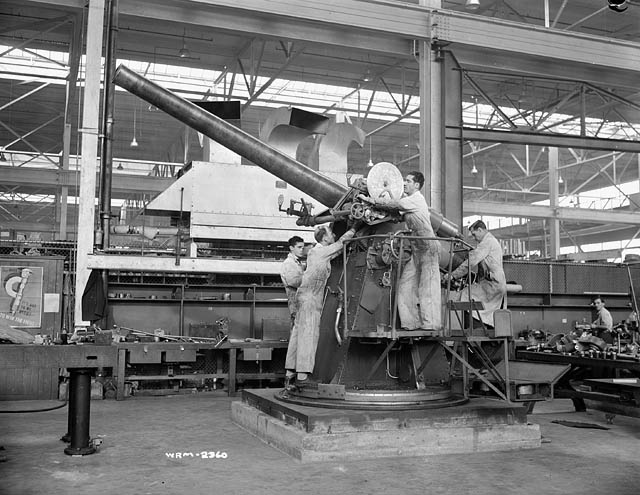
Thes ships were armed with 102 mm (4 in)/45 Schneider-Armstrong modello 1917 single Open Mount installed in line to distribute weight and broadside, one single forward on the forecastle, two on the weather deck aft. Horizontal or vertical sliding breech block.
Cannone da 102/45 Schneider-Armstrong Modello 1917
The Schneider-Armstrong Model 1917 weighted 4,600 kg and had a -5°/+35° elevation, first installed on the Generali-class, Palestro-class, La Masa class, and Giuseppe Sirtori.
Mass: 2,327 kilograms (5,130 lb) 4,600 kg total
Length: 4.7 meters (15 ft 5 in), barrel 4.57 meters (15 ft)
Shell: 13.7–16 kilograms (30–35 lb)
Breech: Horizontal or vertical sliding breech block
Rate of fire: 7 rpm
Muzzle velocity: 850 m/s (2,800 ft/s)
Range: 15,000 m (9.3 mi) at +35° and 8,000 m at max elevation (26,000 ft) with the DP mount.
3-in/40 Modello 1917
It had a pedestal mount going from -10° to +65° elevation, and weighed 1,790 kg (3,950 lb) complete.
Performances were the same as the regular mounted 75 mm/40 Modello 1916. This artillery piece was located aft likely, at the poop. They derived from the licenced QF 12 pounder 12 cwt, Armstrong 76/40 Model 1897.
Full weight 1,676 kg, Length overall 3,139 mm barrel alone 3,048 mm
Rifling; 16 grooves left-handed constant, 76.2 mm
Shell 6.016 to 6.820 kg depending on model Muzzle velocity 690 m/s
12-15 rpm, effective range 5,500 m, max 6,000 m
Elevation +75° on the modello 1917 and 1918.
Torpedoes
The 17.7 inches torpedo tubes (450 mm) used at the time, Thornycroft models built in Italy, by Silurificio Italiano.
No sufficient data on these. 1935 models were rated to reach 3,000 nm at 44 knots. There were four tubes in twin banks, one per side amidships, and stagerred. The aftermost pair, port side, was close to the 3rd funnel, turned forward, and the amidship bank starboard was between the second and third funnel.
Mines
The ships carried also 10 mines as well during wartime. These could be Vickers Elia (VE) 1,676 lbs. (760 kg), 320 lbs. (145 kg) WH, or one of the Sautter-Harlé types M1916 154 or 220 ib.
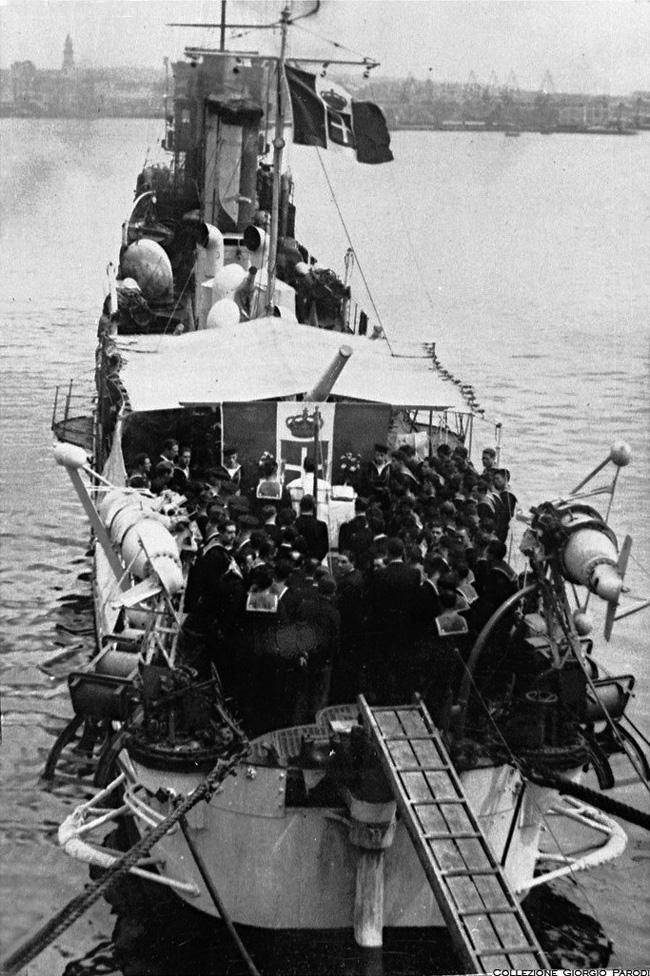
General Achille Papa stern details
Upgrades
After they were re-rated in 1929 as torpedo boats they were left in the same state until 1936 when they were all fitted with a mechanical minesweeping gear for this additional role. In 1939 as wthe war broke up and before Italy went at war, they saw the removal of their old 76mm 3-in/40 AA guns, replaced by two twin 20mm Breda 1935 guns and from two to four 8.80 mm Breda light machine guns. Apparently they lacked ASW grenades and kept their torpedo tubes. Other upgrades included the removal of the aft mast, and the radio cables were attached to two porticos on either side of the third funnel. The main gun was protected by a bulwark-wave-breaker. As for the AA location, there was a twin mount between N°2 and 3 funnels, another aft of N°3 funnel, and two on aither side of N°3 main gun aft, in echelon plus two more on the wings alternatively to the LMGs.
⚙ Base design, Odero. |
|
| Displacement | 832t-890t |
| Dimensions | 73.2m x 7.3m x 3m (240ft 2in x 24ft 11in x 9ft 10in) |
| Propulsion | 2-shaft steam turbines, 4 boilers, 16,000 (20,000 KW) |
| Speed | 30kts (56 km/h; 35 mph) |
| Range | c2000nm/14kts (3,700 km) |
| Armament | 3x 4in/45, 2x 3in/30 AA, 4x 17.7in (450mm) TTs |
| Crew | 105 officers and ratings |
Gallery
 Generale Antonio Cantore
Generale Antonio Cantore
 Cantore was launched on 23 April 1921, completed on 1st july 1922. She only truly was operational from April 1923, and briefly used in training in the Tyrrhenian Sea, and assigned to the II Destroyer Squadron and making a cruise to Tripoli and Cyrenaica. On 20 August in the Corfu crisis, she left Taranto with the sisters Chinotto, Prestinari and Papa, and others, escorting the battleships Duilio and Andrea Doria plus the scout Augusto Riboty to Portolago, Leros, to protect the Dodecanese from possible Greeke actions until the crisis subsided. Cantore also ventured in Greek waters.
Cantore was launched on 23 April 1921, completed on 1st july 1922. She only truly was operational from April 1923, and briefly used in training in the Tyrrhenian Sea, and assigned to the II Destroyer Squadron and making a cruise to Tripoli and Cyrenaica. On 20 August in the Corfu crisis, she left Taranto with the sisters Chinotto, Prestinari and Papa, and others, escorting the battleships Duilio and Andrea Doria plus the scout Augusto Riboty to Portolago, Leros, to protect the Dodecanese from possible Greeke actions until the crisis subsided. Cantore also ventured in Greek waters.
In 1924, Cantore made a cruise, starting with Tobruk in the IX Destroyer Squadron and to the Dodecanese, and then Jaffa, Alexandria, Tobruk and Taranto by January 1926, later stationed in Tripoli and home by 1927, versed to the II Destroyer Squadron, I Squadron. In 1928, she was assigned to the VI Destroyer Squadron and made another cruise off Greece with the VI Squadron. In 1929 with sisters and La Masa she formed the VI Destroyer Squadron led with another by Carlo Mirabello, making the 3rd Flotilla, II Torpedo Division, 2nd Squadron in Taranto. She remained in reserve (IX Reserve Group) in 1930, then La Spezia divisional reserve, I Squadron, then III Torpedo Boat Squadron, operating under the Naval Academy of Livorno, with live firing for the students.
In 1931 she ws led by Aquila and Poerio and the TBs Giacinto Carini and Giuseppe La Farina as the IV Destroyer Squadron, Special Division (Admiral Denti). In 1936 sshe spent a few months in the Red Sea, Naval Division in East Africa and back in Taranto. Until 1939 she remained in reserve at Taranto and Messina, III Torpedo Squadron but was detached to Naples for liaison with the islands of Campania. In 1939 she received a modern AA.
From 10 June 1940, she remained in the III Torpedo Boat Squadron with Prestinari in Naples. She started as escort in the lower Adriatic. On 21 October 1940 she started service for the Albanian High Traffic Command (Maritrafalba) until 12 October 1940, relocated to Brindisi. It seems they could use their ant-mine sweeping gear also for ASW attacks if needed.
On 2 November, Cantore started her first escort mission under Maritrafalba from Brindisi to Valona, another on 4 November to Valona, then from bari on 8 November to Durazzo and again Bari on November 26 to Durazzo. On November 27 she left Durazzo for Bari and on December 1st left for Durazzo. From brindisi on the 5th to Durazzo and back, December 6 from Bari to Valona and back to Brindisi.
On 22 December to Valona, and in the night of 24-25 December took part in rescue operations of the torpedoed steamship Firenze, abandoned adrift. On 26 December she left Valona for Durazzo.
On 5 January 1941 she left Brindisi to Valona, same on January 8, and to Bari. On January 11, Bari to Durazzo, and back to Bari.
On 8 February Naples to Tripoli, first convoy with the Afrika Korps, stopping in Palermo to avoid British Force H. After the invasion of Yugoslavia she focused on escorting vessels, and supplying troops in the islands of Dalmatia and surpress partisan guerrilla on shore.
She returned to convoy escort missions between Greece and Libya, and coastal convoys from Italy to North Africa. On 11 September 1941 she left Patras to escort the steamship Alfredo Oriani, stopped in Brindisi, continued to Benghazi when at 13:15, the merchant was hit and immobilized by British Bristol Blenheim bombers, sinking two days later and she rescued as much as she could. On 18 September Cantore escorted the Donzetti and tanker Urano from Patras to Brindisi.
On 13 December, Cantore and Calliope sailed to meet the IV Cruiser Division (Alberico da Barbiano and Alberto di Giussano) heading to Tripoli but the latter were destroyed by British destroyers off Cape Bon.
On 21 June 1942, Cantore and Circe left Tripoli for rescue operations of the German steamer Reichenfels.
At 13:30 on 21 August 1942 Cantore left Benghazi escorting the tanker Petrarca to Tobruk but on the 22th she struck a mine, part of a barrage laid by HMS Porpoise. She sank rapidly after breaking in two off Ras el Tin, northeast of Tobruk. 23 went down with her. This concluded a wartime career with 210 missions included 105 escorts over 49,000 nautical miles.
 Generale Antonio Cascino
Generale Antonio Cascino
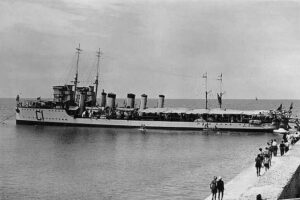 Cascino was laid down on 13 march 1920, launched on 18 March 1922, and completed on 8 May. In the interwar, she had ger initial workout under Maritime Military Department of La Spezia and on November 1922 assigned to the I Destroyer Squadron. Like her sister she took part in the Corfu crisis and sailed to several ports in Greece as a show of force. She operated in the Tyrrhenian Sea, and Tobruk in 1924, also crusing the Dodecanese and up to Alexandria. Later she was departmental ship in Taranto and flagship for the local CiC, cruising to Saseno and Durazzo In March 1927 she was vered to the II Destroyer Squadron, 1st Naval Squadron in Livorno, and worked for the Naval Academy, then Tripoli. On 5 October 1927, while underway from La Spezia to Gaeta, one 76 mm charge locker exploded after spontaneous combustion. The fire spread to the aft ammunition depot but was extinguished by flooding. In 1928 she was in the VI Destroyer Squadron, Special Division and for departmental duties in La Spezia, cruising with officers of the War School. In 1929 she was in Cyrenaica, Alexandria and the Dodecanese.
Cascino was laid down on 13 march 1920, launched on 18 March 1922, and completed on 8 May. In the interwar, she had ger initial workout under Maritime Military Department of La Spezia and on November 1922 assigned to the I Destroyer Squadron. Like her sister she took part in the Corfu crisis and sailed to several ports in Greece as a show of force. She operated in the Tyrrhenian Sea, and Tobruk in 1924, also crusing the Dodecanese and up to Alexandria. Later she was departmental ship in Taranto and flagship for the local CiC, cruising to Saseno and Durazzo In March 1927 she was vered to the II Destroyer Squadron, 1st Naval Squadron in Livorno, and worked for the Naval Academy, then Tripoli. On 5 October 1927, while underway from La Spezia to Gaeta, one 76 mm charge locker exploded after spontaneous combustion. The fire spread to the aft ammunition depot but was extinguished by flooding. In 1928 she was in the VI Destroyer Squadron, Special Division and for departmental duties in La Spezia, cruising with officers of the War School. In 1929 she was in Cyrenaica, Alexandria and the Dodecanese.
As TB she was assigned to the II Torpedo Boat Squadron, Special Division and from 1932 in Venice, VI Division. Until 1937 she remained in the northern Adriatic, cruising to Greece in the summer of 1932 and Cyrenaica 1932-1933 alternating with the Command School in Taranto on 1935.
From 1937 to 1939 she remained in La Spezia as departmental ship, crusiing in the northern Tyrrhenian Sea and Sardinian coast.
When Italy went at war in June 1940, Cascino was part of the II TB Squadron with Chinotto, Montanari and Papa based in La Maddalena. She had her first escort missions along the Italian coast and to North Africa. In 1940 she protected coastal traffic in Libya and in 1941, was transferred to the southern Tyrrhenian Sea and back to North Africa. She also took part in laying 30 minefields, 12 ASW off Sardinia (2196 mines).
On 16-17 September 1940 she was in benghazi during a raid of 15 British Fairey Swordfish from 815th Sqn FAA. They sank the DD Borea and 2 steamers, damaging Cigno, and other laid 680 kg Mk I magnetic mines 75 metres from the mouth of the port. On 17 September it was decided to transfer part of the ships present to Tripoli but on 17th, Cascino was assigned to escort Francesco Barbaro, when at 11.38, the two ran into mines. Barbaro suffering serious damage to the bow and was towed into the western basin by tugs.
Later she escorted Pozzuoli and the tanker Lina Campanella to Palermo and Naples.
At 11.30 on 15 February 1941 Cascino and Pilo were attacked underway to Tripoli, escorting Andrea Gritti, Sebastiano Venier and Caffaro whe torpedoed but missed by an unknown submarine.
On 11 October 1941 she escorted the convoy «Giulia» from Naples on 8 October to Tripoli. They were attacked by Swordfish from 830th Sqn FAA en route from Malta, sinking Zena and Casaregis, which Cascino tried to assist. On 12 October she made an other escort to Tripoli and on the 14th Bainsizza was attacked and damaged by six Swordfish from 830 Sqn. On 16-19 October she left Tripoli to Trapani and back to Tripoli. Beppe was torpedoed and sunk on the 18th by HMS Ursula off Lampedusa. On the 18th they were attacked by five Swordfish from 830th Sqn and Caterina sank.
At 14.30 on 5 January 1942 Cascino left Tripoli for Palermo or Trapani with a steamer. On 7 January, they were attacked by four Fairey Albacore from 828th Squadron based in Malta, 35 miles from Pantelleria. The steamer Perla sank after ten hours with Cascino rescuing the crew (78 men) landed in Trapani.
She then started ladd dangerous escort missions betwee, Italy to Albania, central and southern Adriatic for Balkans operations and the Ionian Sea, Sicily. In May 1942, she made her first mission to Durazzo and then to Bari and two more.
On 14 September 1942 she took part in the defense of Tobruk versus Operation Daffodil. She was moored there with Montanari and Castore, opened fire on ten incoming British MTBs attacked the port in the dark. They claimed sank or damaged some, and repelled the attack. Castore and Montanari recovered and capture British shipwrecked crews and towed some damaged vessels back to port, captured MTB 314, off Marsa Umm el Sciausc, 476 men total and captured two landing craft trying to return to Alexandria.
At the end of 1942, Cascino remained in Libyan waters but in early 1943 was transferred to the southern Tyrrhenian Sea with stops to Bizerta.
Escorting convoys for Tunisia proved tough. In February 1943 she became a fast troop/supply transport due to the Allied mastery of the area. On 12 March 1943, at 00.30, Cascino left Naples for Tunis with Sirio, Orione, Pegaso, Cigno, Ardito, Libra and the Gabbiano class corvettes Cicogna and Persefone, escorting the French merchant ships Esterel and Caraibe on behalf of the German forces and Italian tanker Sterope. At 21.35 on the 12th, they were attacked by British torpedo bombers off Capo San Vito Siculo. Sterope wa sbadly damaged, towed back to Palermo and Cascino, Pegaso, were detached to escort her back to Italy. Esterel wasn badly damaged by HMS Thunderbolt, later sunk by Cicogna.
Cascino was in refit at La Spezia, unable to operate or depart on armistice day and she was scuttled by her crew to avoid capture on 9 September 1943.
She had bee through 228 war missions (158 escort) over 69,000 nautical miles and 3rd most active Italian torpedo boat of the war, her wrecjed refloated and BU in 1947.
 Generale Antonio Chinotto
Generale Antonio Chinotto
 Chinotto was launched on 7 Aug 1921. On 20 August 1923, she sortied to take part in the Corfu crisis. In 1931 with Papa, Nicola Fabrizi and Enrico Cosenz led by Quarto she formed the Special Division of Admiral Denti.
Chinotto was launched on 7 Aug 1921. On 20 August 1923, she sortied to take part in the Corfu crisis. In 1931 with Papa, Nicola Fabrizi and Enrico Cosenz led by Quarto she formed the Special Division of Admiral Denti.
In 1936 she was modified, as well as in 1939. After monthly training activitie from 10 June 1940, she was under escort duties as part of the II Torpedo Boat Squadron with Cascino, Montanari and Papa in La Maddalena. This included convoys to Libya. Between 6 June and 10 July she took part in the laying of 30 minefields, including off Ajaccio.
On 28 March 1941 under Lt. Lelio Campanella she sailed with Missori from Palermo to try finding HMS Rorqual spotted in that area off Capo Gallo. But while heading back for Palermo she hit a mine or two from HMS Rorqual’s barrage, also claiming the tanker Ticino. She broke in two and sank 4 miles northeast of Capo Gallo with 48 officers, petty officers and sailors goiing down with her. She had performed 37 missions. Her wreck was located in 2002 under 103 meters and explored.
 Generale Carlo Montanari
Generale Carlo Montanari
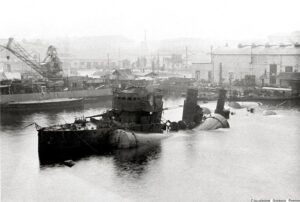 Carlo Montanari was launched on 4 October 1922. She took part from 30 August 1923, to the Corfu crisis (see above). She left Corfu between 24 and 29 September with troops previously landed. In 1927 she was stationed in Tripoli. In 1929 she was in the VI Destroyer Squadron, 3rd Flotilla, II Torpedo Division, 2nd Squadron in Taranto. She was modernized in 1936 and 1939. From 10 June 1940, she was in the II Torpedo Squadron in La Maddalena, for escort missions to Libya and elsewhere, then back by mid-1942. She took part in the Thyerrenian sea minefields. I will ,ot swelve into details of all her escort missions, and just retain here the most important points. Destination from Palermo were Tripoli but also Benghazi. On 10 July Caldea under her guard was torpedoed and she chased down but missed the attacking sub -HMS Taku. She also escoirted ships from Patras to Bari or Taranto to Patras.
Carlo Montanari was launched on 4 October 1922. She took part from 30 August 1923, to the Corfu crisis (see above). She left Corfu between 24 and 29 September with troops previously landed. In 1927 she was stationed in Tripoli. In 1929 she was in the VI Destroyer Squadron, 3rd Flotilla, II Torpedo Division, 2nd Squadron in Taranto. She was modernized in 1936 and 1939. From 10 June 1940, she was in the II Torpedo Squadron in La Maddalena, for escort missions to Libya and elsewhere, then back by mid-1942. She took part in the Thyerrenian sea minefields. I will ,ot swelve into details of all her escort missions, and just retain here the most important points. Destination from Palermo were Tripoli but also Benghazi. On 10 July Caldea under her guard was torpedoed and she chased down but missed the attacking sub -HMS Taku. She also escoirted ships from Patras to Bari or Taranto to Patras.
She rescued some from the auxiliary cruiser Città di Palermo and on 30 January from Corfu to Patras she was attacked but missed by HMS Thunderbolt, was attacked but escaped. On 14 September 1942 she repelled a night raid of MTBs in Tobruk.
On 7 February 1943 in an air raid on Naples by 20 aircraft (9th Air Force) she was badly damaged by a bomb and repairs not complete in La Spezia when the armistice came, she was scuttled by her crew on 9 September 1943, to avoid capture. Refloated but not repaired she was sunk again on 4 October 1944. Refloated in 1949 she was BU.
 Generale Marcello Prestinari
Generale Marcello Prestinari
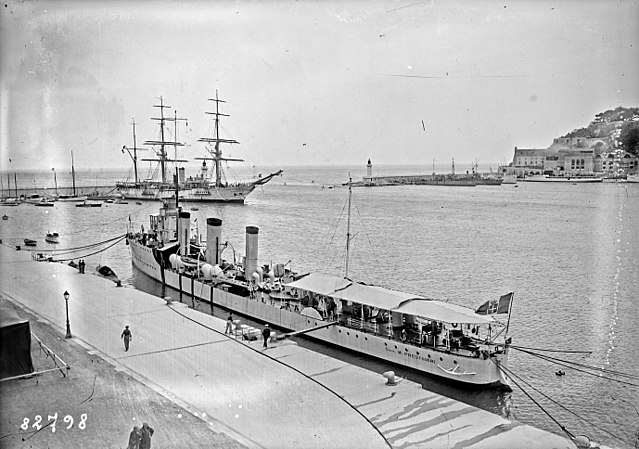 Prestinari was laid down on 23 may 1921, launched on 4 July 1922 and completed on 17 August. On 20 August 1923, she took part in the Corfu crisis. In 1925 she was in the VI Destroyer Squadron, 3rd Flotilla, II Torpedo Division, 2nd Squadron in Taranto. In 1929 she was involved in the search for the Imperial Airways seaplane City of Rome ditched in a storm close to Tino island. Like her sisters she was modernized in 1936 and 1939.
Prestinari was laid down on 23 may 1921, launched on 4 July 1922 and completed on 17 August. On 20 August 1923, she took part in the Corfu crisis. In 1925 she was in the VI Destroyer Squadron, 3rd Flotilla, II Torpedo Division, 2nd Squadron in Taranto. In 1929 she was involved in the search for the Imperial Airways seaplane City of Rome ditched in a storm close to Tino island. Like her sisters she was modernized in 1936 and 1939.
By June 1940, she was in the III Torpedo Squadron with Cantore based in Naples and pressed for convoy escort missions to Libya, Tunisia, Greece, the Tyrrhenian Sea and southern Adriatic. I will no go into detail, check the Italian pages below for more.
She notably worked with Maritrafalba.
On 16 March 1942, she took part in Operation Sirio with Pallade and Francesco Stocco, Ugolino Vivaldi, Lanzerotto Malocello, Emanuele Pessagno and Nicolò Zeno, ezscorting the transport Vettor Pisani from Naples to Tripoli with distant escort by Emanuele Filiberto Duca d’Aosta, Scirocco and Grecale.
On 31 January 1943 Prestinari left Bizerta to assist Procellaria, Persefone and two MAS escorting a convoy with Maestrale towed back to Italy by Animoso. She wa sbadly damaged by a mine from HMS Welshman north-west of Zembra. Four hours after Procellaria hit a mine (potentially laid by Rorqual) she hit a mine also, sinking, in an hour or a few minutes off the Isle of Dogs with 54 officers, petty officers and sailors. Survivors were partly rescued the following day by patrol boats sent on 1 February. Her wreck was not rediscovered yet.
 Generale Achille Papa
Generale Achille Papa
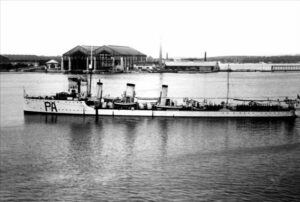 Achille Papa was launched on 8 December 1921. On 20 August 1923, she took part in the Corfu crisis. In 1929, she was in the VI Destroyer Squadron. From 1931 she was in the Special Division for Admiral Denti. She was modernized in 1936 and 1939. On 10 June 1940 she was in the II Torpedo Squadron in La Maddalena. She was used for escort and mine-laying missions, in North African waters and from 1941 in the Tyrrhenian Sea. She took part in the minefield barrages in the waters of Sardinia. On 21 August while leaving Tobruk with a convoy for Benghazi escoring Verace and Doris Ursino she was torpedoed, but missed twice by HMS Rorqual. She dodged three torpedoes and led a counterattack with depth charges, claimed her sunk.
Achille Papa was launched on 8 December 1921. On 20 August 1923, she took part in the Corfu crisis. In 1929, she was in the VI Destroyer Squadron. From 1931 she was in the Special Division for Admiral Denti. She was modernized in 1936 and 1939. On 10 June 1940 she was in the II Torpedo Squadron in La Maddalena. She was used for escort and mine-laying missions, in North African waters and from 1941 in the Tyrrhenian Sea. She took part in the minefield barrages in the waters of Sardinia. On 21 August while leaving Tobruk with a convoy for Benghazi escoring Verace and Doris Ursino she was torpedoed, but missed twice by HMS Rorqual. She dodged three torpedoes and led a counterattack with depth charges, claimed her sunk.
On 30 July 1941 she was atacked by gunfore by the surfaced HMS Cachalot, responded but lost her in the mist and latter spotted her and led a ramming maneuver, sank her north of Benghazi. The crew was made POW. On 12 January 1942 she left Naples with Freccia, escorting a convoy to Tripoli.
On 8 September 1943, she was under repair in Genoa (or La Spezia) and on 9 September, captured by German forces in Genoa, or scuttled in La Spezia to avoid capture and recovered. Whatever the case she was incorporated in the Kriegsmarine as TA 7 on 17 October 1943, then SG 20 and continued as escort ship but hit a mine on 1st November 1943 and badly damaged. She was further damaged when anchored (waiting repairs) in Genoa on 6 January 1944 (US air raid). Finally on 24 April 1945 she was sunk by the Germans in the port of Oneglia to block thes entrance or in Genoa by the 6 January 1944 raid and later on 12 or 16 January 1944, recovered in April 1945 and sunk again at Oneglia on 25 April. She was refloated in 1947 and BU.
Read More/Src
Books
Fraccaroli, Aldo (1985). “Italy”. In Gray, Randal (ed.). Conway’s All the World’s Fighting Ships 1906–1921. NIP
Roberts, John (1980). “Italy”. In Chesneau, Roger (ed.). Conway’s All the World’s Fighting Ships 1922–1946. New York: Mayflower Books.
La Racine, R. B. (March 2011). “In Adriatico subito dopo la vittoria”. Storia Militare (in Italian). No. 210.
Giorgio Giorgerini, La guerra italiana sul mare. La Marina tra vittoria e sconfitta 1940-1943, p. 262 (in Italian).
Whitley, M. J. (1988). Destroyers of World War Two: An International Encyclopedia. NIP
Links
https://www.marina.difesa.it/noi-siamo-la-marina/pilastro-operativo/mezzi/mezzi-storici/Pagine/EFGHI/gen_papa.aspx
https://www.navypedia.org/ships/italy/it_dd_generali.htm
http://www.trentoincina.it/dbunita2.php?short_name=Prestinari
http://www.trentoincina.it/dbunita2.php?short_name=Montanari
http://www.trentoincina.it/dbunita2.php?short_name=Chinotto
http://www.trentoincina.it/dbunita2.php?short_name=Cascino
http://www.trentoincina.it/dbunita.php?unit=Cantore
http://www.trentoincina.it/dbunita2.php?short_name=Papa
https://it.wikipedia.org/wiki/Classe_Generali
https://en.wikipedia.org/wiki/Generali-class_destroyer
https://navyworld.narod.ru/Cacciatorpediniere.htm#Generale_Carlo_Montanari
Model Kits
Afrika Corps Convoy 1 1941.9 Benghazi Fairy Kikaku | No. S093 | 1:700


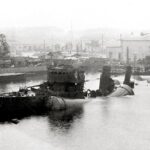
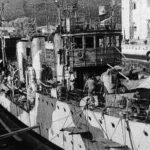
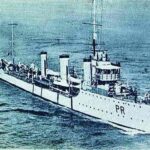
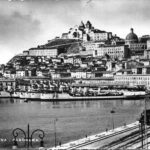
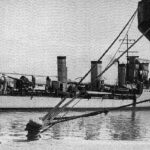

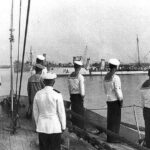
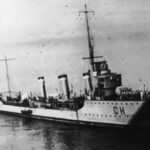
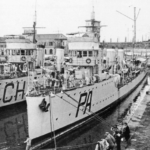
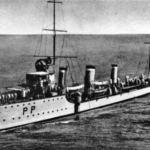

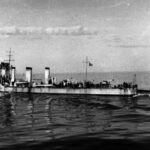
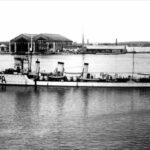
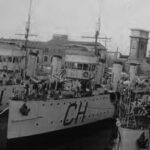
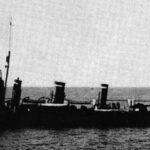
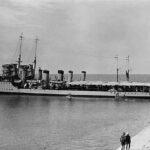
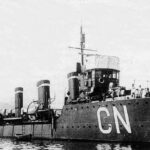
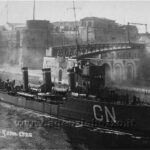
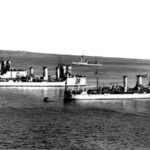
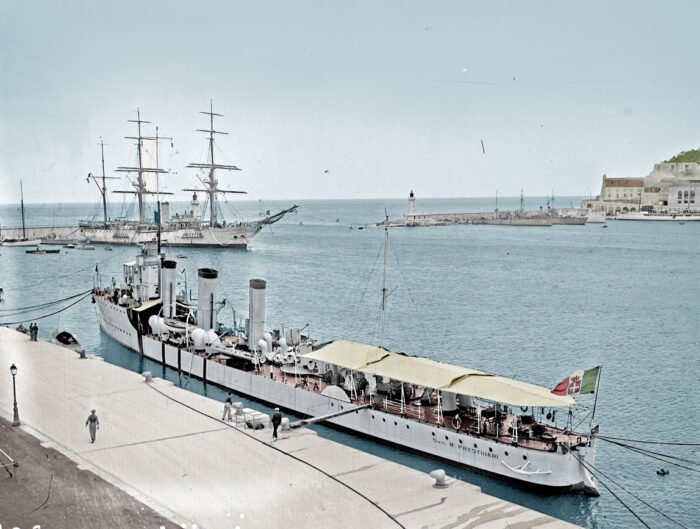
 Latest Facebook Entry -
Latest Facebook Entry -  X(Tweeter) Naval Encyclopedia's deck archive
X(Tweeter) Naval Encyclopedia's deck archive Instagram (@navalencyc)
Instagram (@navalencyc)





 French Navy
French Navy Royal Navy
Royal Navy Russian Navy
Russian Navy Armada Espanola
Armada Espanola Austrian Navy
Austrian Navy K.u.K. Kriegsmarine
K.u.K. Kriegsmarine Dansk Marine
Dansk Marine Nautiko Hellenon
Nautiko Hellenon Koninklije Marine 1870
Koninklije Marine 1870 Marinha do Brasil
Marinha do Brasil Osmanlı Donanması
Osmanlı Donanması Marina Do Peru
Marina Do Peru Marinha do Portugal
Marinha do Portugal Regia Marina 1870
Regia Marina 1870 Nihhon Kaigun 1870
Nihhon Kaigun 1870 Preußische Marine 1870
Preußische Marine 1870 Russkiy Flot 1870
Russkiy Flot 1870 Svenska marinen
Svenska marinen Søværnet
Søværnet Union Navy
Union Navy Confederate Navy
Confederate Navy Armada de Argentina
Armada de Argentina Imperial Chinese Navy
Imperial Chinese Navy Marinha do Portugal
Marinha do Portugal Mexico
Mexico Kaiserliche Marine
Kaiserliche Marine 1898 US Navy
1898 US Navy Sovietskiy Flot
Sovietskiy Flot Royal Canadian Navy
Royal Canadian Navy Royal Australian Navy
Royal Australian Navy RNZN Fleet
RNZN Fleet Chinese Navy 1937
Chinese Navy 1937 Kriegsmarine
Kriegsmarine Chilean Navy
Chilean Navy Danish Navy
Danish Navy Finnish Navy
Finnish Navy Hellenic Navy
Hellenic Navy Polish Navy
Polish Navy Romanian Navy
Romanian Navy Turkish Navy
Turkish Navy Royal Yugoslav Navy
Royal Yugoslav Navy Royal Thai Navy
Royal Thai Navy Minor Navies
Minor Navies Albania
Albania Austria
Austria Belgium
Belgium Columbia
Columbia Costa Rica
Costa Rica Cuba
Cuba Czechoslovakia
Czechoslovakia Dominican Republic
Dominican Republic Haiti
Haiti Hungary
Hungary Honduras
Honduras Estonia
Estonia Iceland
Iceland Eire
Eire Equador
Equador Iran
Iran Iraq
Iraq Latvia
Latvia Liberia
Liberia Lithuania
Lithuania Mandchukuo
Mandchukuo Morocco
Morocco Nicaragua
Nicaragua Persia
Persia San Salvador
San Salvador Sarawak
Sarawak Uruguay
Uruguay Venezuela
Venezuela Zanzibar
Zanzibar Warsaw Pact Navies
Warsaw Pact Navies Bulgaria
Bulgaria Hungary
Hungary

 Bundesmarine
Bundesmarine Dutch Navy
Dutch Navy Hellenic Navy
Hellenic Navy Marina Militare
Marina Militare Yugoslav Navy
Yugoslav Navy Chinese Navy
Chinese Navy Indian Navy
Indian Navy Indonesian Navy
Indonesian Navy JMSDF
JMSDF North Korean Navy
North Korean Navy Pakistani Navy
Pakistani Navy Philippines Navy
Philippines Navy ROKN
ROKN Rep. of Singapore Navy
Rep. of Singapore Navy Taiwanese Navy
Taiwanese Navy IDF Navy
IDF Navy Saudi Navy
Saudi Navy Royal New Zealand Navy
Royal New Zealand Navy Egyptian Navy
Egyptian Navy South African Navy
South African Navy






























 Ukrainian Navy
Ukrainian Navy dbodesign
dbodesign